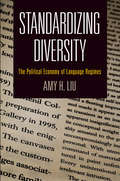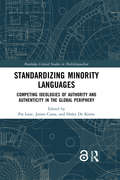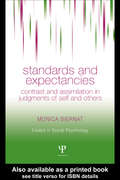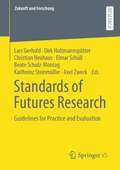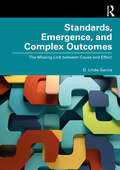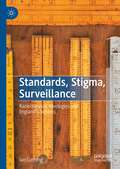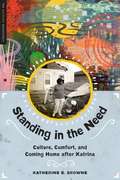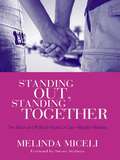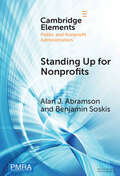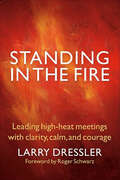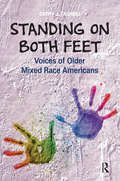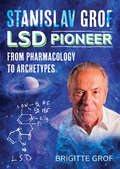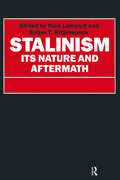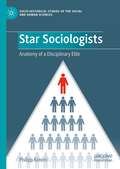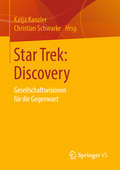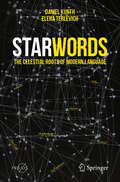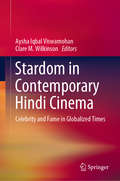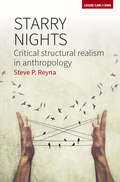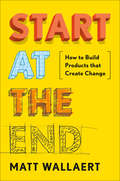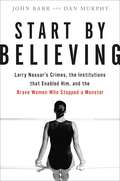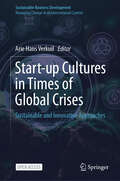- Table View
- List View
Standardizing Diversity: The Political Economy of Language Regimes (National and Ethnic Conflict in the 21st Century)
by Amy H. LiuLanguages have deep political significance beyond communication: a common language can strengthen cultural bonds and social trust, or it may exacerbate cultural differences and power imbalances. Language regimes that emerge from political bargains can centralize power by favoring the language of one ethnolinguistic group, share power by recognizing multiple mother tongues, or neutralize power through the use of a lingua franca. Cultural egoism, communicative efficiency, or collective equality determines the choice. As Amy H. Liu demonstrates, the conditions surrounding the choice of a language regime also have a number of implications for a nation's economy.Standardizing Diversity examines the relationship between the distribution of linguistic power and economic growth. Using a newly assembled dataset of all language-in-education policies in Asia from 1945 to 2005 and drawing on fieldwork data from Malaysia and Singapore, Liu shows language regimes that recognize a lingua franca exclusively—or at least above all others—tend to develop social trust, attract foreign investment, and stimulate economic growth. Particularly at high levels of heterogeneity, the recognition of a lingua franca fosters equality and facilitates efficiency. Her findings challenge the prevailing belief that linguistic diversity inhibits economic growth, suggesting instead that governments in even the most ethnically heterogeneous countries have institutional tools to standardize their diversity and to thrive economically.
Standardizing Minority Languages: Competing Ideologies of Authority and Authenticity in the Global Periphery (Routledge Critical Studies in Multilingualism)
by Pia Lane James Costa Haley De KorneThe Open Access version of this book, available at https://www.taylorfrancis.com/books/9781138125124, has been made available under a Creative Commons Attribution-Non Commercial-No Derivatives 4.0 license. This volume addresses a crucial, yet largely unaddressed dimension of minority language standardization, namely how social actors engage with, support, negotiate, resist and even reject such processes. The focus is on social actors rather than language as a means for analysing the complexity and tensions inherent in contemporary standardization processes. By considering the perspectives and actions of people who participate in or are affected by minority language politics, the contributors aim to provide a comparative and nuanced analysis of the complexity and tensions inherent in minority language standardisation processes. Echoing Fasold (1984), this involves a shift in focus from a sociolinguistics of language to a sociolinguistics of people. The book addresses tensions that are born of the renewed or continued need to standardize ‘language’ in the early 21st century across the world. It proposes to go beyond the traditional macro/micro dichotomy by foregrounding the role of actors as they position themselves as users of standard forms of language, oral or written, across sociolinguistic scales. Language policy processes can be seen as practices and ideologies in action and this volume therefore investigates how social actors in a wide range of geographical settings embrace, contribute to, resist and also reject (aspects of) minority language standardization.
Standards and Expectancies: Contrast and Assimilation in Judgments of Self and Others (Essays in Social Psychology)
by Monica BiernatThis book examines how standards and expectancies affect judgments of others and the self. Standards are points of comparison, expectancies are beliefs about the future, and both serve as frames of reference against which current events and people (including the self) are experienced. The central theme of the book is that judgments can be characterized as either assimilative or contrastive in nature. Assimilation occurs when the target of evaluation (another person, the self) is pulled toward or judged consistently with the standard or expectation, and contrast occurs when the target is differentiated from (judged in a direction opposite) the comparative frame. The book considers factors that determine whether assimilation versus contrast occurs, and focuses on the roles of contextual cues, the self, and stereotypes as standards for judging others, and the roles of internalized guides, stereotypes, and other people for judging the self.
Standards of English
by Raymond HickeyThe notion of a 'standard' variety of English has been the subject of a considerable body of research. Studies have tended to focus on the standard features of British and American English. However, more recently interest has turned to the other varieties of English that have developed around the world and the ways in which these have also been standardised. This volume provides the first book-length exploration of 'standard Englishes', with chapters on areas as diverse as Canada, the Caribbean, Africa, Asia, New Zealand and the South Pacific. This is a timely and important topic, edited by a well-known scholar in the field, with contributions by the leading experts on each major variety of English discussed. The book presents in full the criteria for defining a standard variety, and each chapter compares standards in both spoken and written English and explores the notion of register within standard varieties.
Standards of English in Higher Education
by Neil MurrayThe student demographic of universities today has changed quite dramatically from even a decade ago. As universities seek to internationalise, widen participation and derive attendant reputational and financial benefits, along with greater opportunities for research collaborations and industry links, they also face a growing challenge associated with what Neil Murray terms 'the English language question'. In particular, as the proportion of students of non-English speaking backgrounds entering universities increases, there is growing concern over levels of language proficiency and what this can mean for educational standards, the student experience and, ultimately, institutional standing. Standards of English in Higher Education unpacks a number of key and interrelated issues - for example, the assessment of proficiency and the structure and nature of provision - that bear on the question of English language standards and in doing so offers a frank critical appraisal of English language in higher education today.
Standards of Futures Research: Guidelines for Practice and Evaluation (Zukunft und Forschung)
by Axel Zweck Karlheinz Steinmüller Lars Gerhold Dirk Holtmannspötter Christian Neuhaus Elmar Schüll Beate Schulz-MontagForesight, futures studies, but also technology assessment and trend research are characterized by a research perspective directed towards the future. These results in fundamental peculiarities have to be taken into account in the conception of studies and in practical research work. The contributions to this anthology offer guidance for scientists and practitioners and describe the criteria and standards by which the quality of results and processes in futures studies can be assessed.
Standards, Emergence, and Complex Outcomes: The Missing Link between Cause and Effect
by D. Linda GarciaStandards, Emergence, and Complex Outcomes redefines how we think about standards, framing them as interfaces that govern interactions and connect causes to their effects. Expanding beyond traditional technical and geopolitical discussions, Garcia introduces a fresh theoretical perspective that positions standards as central to understanding complexity. From food safety and workplace regulations to standardized parts in manufacturing and our reliance on technology, standards shape nearly every aspect of modern life.By proposing a multidimensional approach, Garcia argues that standards are the mechanisms driving change, complexity is the backdrop for this change, emergence is the process by which change unfolds, and evolution is its ultimate outcome. Each chapter explores key elements of complexity theory and supports them with compelling historical and empirical examples, providing a richly detailed narrative that deepens understanding.This book is an essential resource for academics and students across the social sciences, policymakers shaping standards-dependent fields, and professionals in industries where standards dictate progress. Whether you're exploring the intersections of technology, governance, and complexity or looking to better navigate the systems shaping our world, this book offers vital insights into the pivotal role of standards in our increasingly interconnected society.
Standards, Stigma, Surveillance: Raciolinguistic Ideologies and England’s Schools
by Ian CushingThis book traces raciolinguistic ideologies in England’s schools, focusing on post- 2010 policy reforms which frame the language practices of low-income, racialised speakers as limited and deficient. Across interviews, policy mechanisms and classroom observations, the author shows how raciolinguistic ideologies are rooted in British colonial logics which continue to shape contemporary education policy. He shows how these policies require marginalised speakers to modify their speech patterns in line with normative standards of whiteness under new guises of social justice and research robustness. Finally, new visions for language education and linguistic justice are offered, demonstrating how teachers can see themselves as language activists to identify, resist and reject faults in a hostile and oppressive policy architecture. This book draws on fields including critical language policy, educational sociolinguistics, genealogy, raciolinguistics and critical language awareness.
Standing In The Need: Culture, Comfort, And Coming Home After Katrina
by Katherine E. BrowneStanding in the Need presents an intimate account of an African American family's ordeal after Hurricane Katrina. Before the storm struck, this family of one hundred fifty members lived in the bayou communities of St. Bernard Parish just outside New Orleans. Rooted there like the wild red iris of the coastal wetlands, the family had gathered for generations to cook and share homemade seafood meals, savor conversation, and refresh their interconnected lives. In this lively narrative, Katherine Browne weaves together voices and experiences from eight years of post-Katrina research. Her story documents the heartbreaking struggles to remake life after everyone in the family faced ruin. Cast against a recovery landscape managed by outsiders, the efforts of family members to help themselves could get no traction; outsiders undermined any sense of their control over the process. In the end, the insights of the story offer hope. Written for a broad audience and supported by an array of photographs and graphics, Standing in the Need offers readers an inside view of life at its most vulnerable.
Standing Out, Standing Together: The Social and Political Impact of Gay-Straight Alliances
by Melinda MiceliJust a decade ago, requests by students to establish groups to support gay and lesbian students were rare and generally met with shock and confusion by school administrators and local communities. Today there are more than 1600 gay straight alliances (GSAs) across the country. Standing Out, Standing Together documents the emergence of gay straight alliances in public schools across America - from factors that have contributed to the relatively rapid spread of GSA to those that stirred controversy and posed roadblocks. Using over 10 years of interviews with students, teachers, administrators and political activists; case studies; and local and national media reports, Miceli explores the personal and political stakes involved in the battles over GSAs. Although the book acknowledges and documents the harassment, abuse and problems suffered by many gay, lesbian, transgendered, and bisexual students, its primary focus is on these students as political activists, rather than as passive victims, making it a unique contribution to sociologists, educators, political activists and LGBTreaders alike.
Standing Up for Nonprofits: Advocacy on Federal, Sector-wide Issues (Elements in Public and Nonprofit Administration)
by Benjamin Soskis Alan J. AbramsonThis Element examines the recent history of nonprofit sector-wide advocacy at the federal level, focusing on work done by national nonprofit infrastructure organizations and national charities, to advocate on issues, such as tax incentives for charitable giving, that affect a broad range of nonprofits. The Element draws on interviews with thirty-nine national and state nonprofit leaders and federal policymakers as well as published papers and journalistic accounts. It finds that many policymakers are only weakly supportive of the nonprofit sector. In the end, this Element points to an uneasy, shifting balance in nonprofit sector advocacy between informal, decentralized, issue-based coalitions focused on short-term, if vital, legislative victories, on one hand, and the public good mandate embraced by some sector-wide advocates, which attends to longer time horizons and a broad conception of the defense of civil society, on the other. This title is also available as Open Access on Cambridge Core.
Standing by Words: Essays
by Wendell BerryIn these six essays, award-winning author Wendell Berry considers the degeneration of language that is manifest throughout our culture, from poetry to politics, from conversation to advertising, and he shows how the ever widening cleft between words and their referents mirrors the increasing isolation of individuals from their communities and of their communities from the land.
Standing in the Fire: Leading high-heat meetings with clarity, calm, and courage
by Larry DresslerFrom an accomplished international facilitator, &“a must-read for anyone who must navigate through a sea of emotionally charged issues&” (Russell Coff, Associate Professor of Organization and Management, Emory University). Experienced facilitators, OD consultants, coaches, and organizational leaders increasingly find themselves standing in the fire—working in situations where group and community members are polarized, angry, fearful, and confused. Facilitator Larry Dressler has come to believe that simply picking up yet another method or technique won&’t help in situations like these. What has a truly transformational impact is what he calls the &“facilitators presence.&” Cultivating an ability to access a compassionate presence that people experience as open, authentic, and clear in intention during the most difficult situations moves facilitators from being competent professionals to being on a path toward self-mastery. In this helpful guide, he explains how to make that transformation happen.
Standing on Both Feet: Voices of Older Mixed-Race Americans
by Cathy J TashiroIn the first book to focus on the experiences of older Americans of mixed race, Cathy J. Tashiro explores questions of identity and the significance of family experiences, aging and the life course, class, gender, and nationality. Including African American/White and Asian American/White individuals, the book highlights the poignant voices of people who embodied the transgression of the color line. Their very existence violated deep cultural beliefs in the distinctiveness of the races at the time. Based on extensive interviews, the book offers a unique perspective on the social construction of race and racism in America.Check out the website for "Standing on Both Feet" here!
Stanislav Grof, LSD Pioneer: From Pharmacology to Archetypes
by Brigitte GrofCelebrating the groundbreaking life&’s work of Stanislav Grof, MD, pioneer in psychedelic research and transpersonal psychology• Features an extended interview with Stan Grof, exploring in great depth the full arc of his lifelong research in his own words as well as the history of LSD • Discusses his early experiments with LSD in Czechoslovakia and the USA during the 1950s and &’60s, his discovery of the perinatal matrices, the creation of holotropic breathwork, and his own LSD experiences • Includes testimonies from a number of luminaries in the psychedelic and psychological domains, including Jack Kornfield, Rupert Sheldrake, Ervin Laszlo, Richard Tarnas, Rick Doblin, Roger Walsh, David Steindl-Rast, and Fritjof Capra Created in honor of his 90th birthday, this book celebrates the profound life&’s work of Stanislav Grof, MD, pioneer in psychedelic research and transpersonal psychology. Featuring an extended interview between Stan and his wife, Brigitte, the book explores in depth the full arc of his research in his own words as well as the history of LSD. He discusses his early experiments with LSD in Czechoslovakia and the USA during the 1950s and &’60s and the cartography of the psyche that resulted. He describes his clients&’ and his own experiences and the psychedelic approach he pioneered. He explains the four perinatal matrices, illustrated with the impressive paintings he made during high-dose LSD sessions. He discusses the creation of holotropic breathwork as a way to reach expanded states of consciousness without the use of drugs. He describes how he started work with LSD believing it was simply pharmacology and then went on to discover the perinatal, transpersonal, and archetypal levels of the psyche through his lifelong research. The book also features testimonies from a number of luminaries in the psychedelic, psychological, scientific, and spiritual communities, including Jack Kornfield, Rupert Sheldrake, Ervin Laszlo, Richard Tarnas, Rick Doblin, Roger Walsh, David Steindl-Rast, Fritjof Capra, and Cathy Coleman. Complete with captivating photos of Stan Grof with Albert Hofmann, Swiss painter H. R. Giger, Fritz Perls, Sasha Shulgin, as well as all of the book&’s contributors, this special book presents an impressive overview of Stan Grof&’s groundbreaking work and honors his importance as a psychedelic elder.
Stanlinism: Essays In Honour Of Moshe Lewin (Studies In Russian And East European History And Society Ser.)
by Nick LampertAlthough scholars have devoted much attention to the impact of technology on society, they have tended to slight the question of how technology is affected by social systems. The authors of this volume take precisely this approach in their examination of the "Soviet model" of development.
Star Sociologists: Anatomy of a Disciplinary Elite (Socio-Historical Studies of the Social and Human Sciences)
by Philipp KoromThis book aims to overcome sociology’s preoccupation with individual authors by exploring a larger social phenomenon that occurs in all academic disciplines but has been paid little attention: the prestige elite. Members of this elite attain the highest levels of peer recognition, their books sometimes circulate by the hundreds of thousands, and every student has read about them. Based on large citation studies, Star Sociologists provides a roster of eminent sociologists, documents the changing elite’s composition over time, contrasts the elite’s career pathways with those of the Nobel Laureates in economics, gives insights into how scholars rise to or fall from eminence, and empirically probes the gatekeeping power of one of its key proponents. The book explores eminence by contextualising conditions that are outside of the elite and argues that in any discipline that is intellectually as disintegrated as sociology, eminence is to be understand as a nested phenomenon: scholars make it into the elite if their ideas are adopted in very different intellectual fields that share little common ground.
Star Trek: Gesellschaftsvisionen für die Gegenwart
by Katja Kanzler Christian SchwarkeDie neue Star-Trek-Serie Discovery thematisiert die gegenwärtige Unsicherheit über die Zukunft der westlichen Gesellschaften. Die Beiträge des Bandes zeigen, welche Möglichkeiten die Serie durchspielt. Spiegeluniversen, Zeitreisen, Klingonen und Terraner halten der Gegenwart einen Spiegel vor, in dem Utopien und Dystopien sichtbar werden. Der InhaltStar Trek und die neue Unübersichtlichkeit. Eine Einführung.- Amerikanische Befindlichkeiten in Star Trek: Discovery.- Star Trek als das „einzig greifbare Beispiel“ einer gelingenden Zukunft? Zur semantischen Krise normativer Potentiale.- Star Trek und der Traum von der Allgegenwart. Technik und die Realisierung von Utopien.- Interstellare Gerechtigkeit. Star Treks Ideal einer speziespluralistischen Gesellschaft.- Zwischen Serenity undDiscovery: Female Warriors in Science Fiction. Zwischenräume von Klischee und Agency.- Star Trek: Discovery: Fremdsetzung, Serialität und der Star Trek-KanonDie ZielgruppenStudierende, Wissenschaftler*innen und Lehrende der Geistes-, Medien- und SozialwissenschaftenDie Herausgeber*innenProf. Dr. Katja Kanzler ist Inhaberin des Lehrstuhls für amerikanische Literatur an der Universität Leipzig.Prof. Dr. Christian Schwarke ist Inhaber des Lehrstuhls für Systematische Theologie an der TU Dresden.
StarWords: The Celestial Roots of Modern Language (Springer Praxis Books)
by Daniel Kunth Elena TerlevichUnbeknownst to many, our modern language contains countless words that were inspired by human observations of the cosmos. We now use words like “zenith”, “Monday”, “disaster”, “dog days”, “starfish”, “lunatic”, flu, and so many others, without a second thought for their celestial roots. Famous French astrophysicist Daniel Kunth invites you on a linguistic and scientific journey through space and time to explore these forgotten origins. You will be astonished to rediscover cosmic language hidden in plain sight through this wonderful collection of historical and cultural stories, famous idioms and delightful puns, along with the real science behind each one. Elena Terlevich is a well known professional astronomer working at INAOE in Mexico, an honorary Professor at La Plata University in Argentina and a regular visitor at the Institute of Astronomy in Cambridge (UK). Requiring no prior knowledge in astronomy or linguistics, this book’s universal contentsinvite the reader to ponder how our observations of the night sky have shaped our modern tongue and customs.
Stardom in Contemporary Hindi Cinema: Celebrity and Fame in Globalized Times
by Aysha Iqbal Viswamohan Clare M. WilkinsonIn this book, film scholars, anthropologists, and critics discuss star-making in the contemporary Hindi-language film industry in India, also known as “Bollywood.” Drawing on theories of stardom, globalization, transnationalism, gender, and new media studies, the chapters explore contemporary Hindi film celebrity. With the rise of social media and India’s increased engagement in the global economy, Hindi film stars are forging their identities not just through their on-screen images and magazine and advertising appearances, but also through an array of media platforms, product endorsements, setting fashion trends, and involvement in social causes. Focusing on some of the best-known Indian stars since the late 1990s, the book discusses the multiplying avenues for forging a star identity, the strategies industry outsiders adopt to become stars, and the contradictions and conflicts that such star-making produces. It addresses questions such as: What traits of contemporary stars have contributed most to longevity and success in the industry? How has filmmaking technology and practice altered the nature of stardom? How has the manufacture of celebrity altered with the recent appearance of commodity culture in India and the rise of a hyper-connected global economy? By doing so, it describes a distinct moment in India and in the world in which stars and stardom are drawn more closely than ever into the vital events of global culture. Hindi films and their stars are part of the national and global entertainment circuits that are bigger and more competitive than ever. As such, this is a timely book creates opportunities for examining stardom in other industries and provides fruitful cross-cultural perspectives on star identities today."Grounded in rigorous scholarship as well as a palpable love of Hindi cinema, this collection of 19 essays on a dizzying array of contemporary Hindi film stars makes for an informative, thought-provoking, illuminating, and most of all, a joyful read. Pushing boundaries of not only global Star Studies but also film theory as a whole, this de-colonised and de-colonising volume is a must read for film scholars, students and cinephiles!" Dr. Sunny Singh, Senior Lecturer - Creative Writing and English Literature, Sir John Cass School of Art, Architecture & Design, London Metropolitan University “A wide-ranging overview of Hindi cinema’s filmi firmament today, focussing on its most intriguing and brightest-burning stars. The variety of approaches to stardom and celebrity by both established and upcoming scholars reveals a web of interconnecting stories and concerns that provide fascinating new insights into the workings of today's Hindi film industry, while shining fresh light on contemporary India and the world we live in.” Professor Rosie Thomas, Centre for Research and Education in Arts and Media (CREAM), College of Design, Creative and Digital Industries, University of Westminster
Stargazing: Celebrity, Fame, and Social Interaction (Sociology Re-Wired)
by Scott R. Harris Kerry O. FerrisThe sociology of fame and celebrity is at the cutting edge of current scholarship in a number of different areas of study. Stargazing highlights the interactional dynamics of celebrity and fame in contemporary society, including the thoughts and feelings of stars on the red carpet, the thrills and risks of encountering a famous person at a convention or on the streets, and the excitement generated even by the obvious fakery of celebrity impersonators. Using compelling, real-life examples involving popular celebrities, Ferris and Harris examine how the experience and meanings of celebrity are shaped by social norms, interactional negotiations, and interpretive storytelling.
Starry Nights: Critical Structural Realism in Anthropology
by Stephen P. ReynaStarry Nights: Critical Structural Realism in Anthropology offers nothing less than a reinventing of the discipline of anthropology. In these six essays – four published here for the first time – Stephen Reyna critiques the postmodern tenets of anthropology, while devising a new strategy for conducting research. Combative and clear, Starry Nights provides an important critique of mainstream anthropology as represented by Geertz and the postmodern legacy, and envisions a mode of anthropological research that addresses social, cultural and biological questions with techniques that are theoretically rigorous and practically useful.
Start at the End: How to Build Products That Create Change
by Matt WallaertNudge meets Hooked in a practical approach to designing products and services that change behavior, from what we buy to how we work.Deciding what to create at modern companies often looks like an episode of Mad Men: people throw ideas around until one sounds sexy enough to execute and then they scale it to everyone. The result? Companies overspend on marketing to drive engagement with products and services that people don't want and won't help them be happier and healthier.Start at the End offers a new framework for design, grounded in behavioral science. Technology executive and behavioral scientist Matt Wallaert argues that the purpose of everything is behavior change. By starting with outcomes instead of processes, the most effective companies understand what people want to do and why they aren't already doing it, then build products and services to bridge the gap.Wallaert is a behavioral psychologist who has led product design at organizations ranging from startups like Clover Health to industry leaders such as Microsoft. Whether dissecting the success behind Uber's ridesharing service or Flamin' Hot Cheetos, he underscores with clarity and humor how this approach can improve the way we work and live. This is an essential roadmap for building products that matter--and changing behavior for the better.
Start by Believing: Larry Nassar's Crimes, the Institutions that Enabled Him, and the Brave Women Who Stopped a Monster
by Dan Murphy John BarrThe definitive, devastating account of the largest sex abuse scandal in American sports history-with new details and insights into the institutional failures, as well as the bravery that brought it to light.For decades, osteopathic physician Larry Nassar built a sterling reputation as the go-to doctor for America's Olympians while treating countless others at his office on Michigan State University's campus. It was largely within the high-pressure world of competitive gymnastics that Nassar exploited young girls, who were otherwise motivated by fear and intimidation, sexually assaulting hundreds of them under the guise of medical treatment. In Start by Believing, John Barr and Dan Murphy confront Nassar's acts, which represent the largest sex abuse scandal to impact the sporting world. Through never-before-released interviews and documents they deconstruct the epic institutional failures and individuals who enabled him. When warnings were raised, self-serving leaders chose to protect their organizations' reputations over the well-being of young people. Following the paths traveled by courageous women-featuring a once-shy Christian attorney and a brash, outspoken Olympic medalist-Barr and Murphy detail the stories of those who fought back against the dysfunction within their sport to claim a far-from-inevitable victory. The gymnasts' uncommon perseverance, along with the help of dedicated advocates brought criminals to justice and helped to fuel the #MeToo revolution. Start by Believing reveals the win-at-all-costs culture in elite athletics and higher education that enabled a quarter century of heinous crimes.
Start-up Cultures in Times of Global Crises: Sustainable and Innovative Approaches (Sustainable Business Development)
by Arie Hans VerkuilThis open access volume analyses the challenges, problems and solutions of startups in times of global crises. It, first, provides an overview of the principles and fundamentals of successful entrepreneurship and startup development and talks about important resilience factors for meaningful entrepreneurship. Then, it analyses the findings and events that have come to light during the Covid-19 crisis and the Ukraine war. The volume discusses examples of successful and unsuccessful entrepreneurship for startups and small businesses in various Asian countries and thereby also provides an international perspective. Against these discussions, the contributors talk about possible political framework conditions for successful entrepreneurship. The volume overall provides experts in the fields of organizational studies, well-being and resilience research, economic policy, economic promotion, and science with a useful resource that condenses and summarizes current economic crises, financial crises and political crises from the perspective of entrepreneurship. The findings produced here are the result of many years of international research cooperation between the contributors and the editor.
